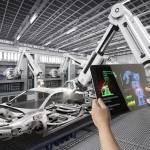In today’s competitive manufacturing landscape, product aesthetics play a crucial role in consumer satisfaction and brand reputation. Even minor surface imperfections can significantly impact a product’s market acceptance. To address this, industries are increasingly adopting advanced technologies like Automated Optical Inspection (AOI) systems and machine vision systems for aesthetic defect detection. These systems leverage artificial intelligence (AI) and high-resolution imaging to identify and classify surface defects with unparalleled accuracy and efficiency.
Understanding Aesthetic Defects
Aesthetic defects refer to visual imperfections on a product’s surface that, while not necessarily affecting functionality, can diminish its visual appeal. Common examples include:
- Surface Scratches and Scuffs: Often resulting from handling or machining processes.
- Dents and Deformations: Caused by impacts or manufacturing errors.
- Color Variations: Uneven application of coatings or paints.
- Texture Inconsistencies: Variations in surface smoothness or patterns.
- Contaminations: Presence of dust, oil, or foreign particles embedded during production.
- Assembly Misalignments: Visible gaps or offsets in assembled parts.
Detecting these defects is vital across various sectors, including automotive, electronics, consumer goods, and luxury items, where visual appeal directly influences consumer choices.
Challenges in Traditional Aesthetic Defect Detection
Traditional methods of aesthetic defect detection primarily rely on human inspectors. While human judgment is valuable, this approach presents several challenges:
- Subjectivity: Human inspections can be inconsistent due to varying perceptions of defects.
- Fatigue and Attention Variability: Prolonged inspection periods can lead to decreased attention and increased oversight.
- Scalability Issues: Manual inspections are time-consuming and may not keep pace with high-speed production lines.
- Difficulty with Complex Surfaces: Textured, reflective, or intricate surfaces can make defect detection challenging for the human eye.
Advancements with Machine Vision Systems
To overcome these challenges, manufacturers are turning to machine vision systems integrated with AI. These systems offer:
- High-Resolution Imaging: Captures detailed images of product surfaces, enabling the detection of minute defects.
- Consistent and Objective Analysis: AI algorithms provide uniform criteria for defect detection, eliminating subjectivity.
- Speed and Efficiency: Capable of inspecting products at high speeds, aligning with modern production demands.
- Adaptability: Can be trained to recognize a wide range of defects across different materials and surfaces.
Components of an Effective AOI System
An effective Automated Optical Inspection (AOI) system for aesthetic defect detection comprises several key components:
- Imaging Devices: High-resolution cameras, such as area scan or line scan cameras, capture detailed images of the product surfaces.
- Illumination Systems: Proper lighting, including ring lights, coaxial lights, or structured lighting, enhances defect visibility.
- AI-Powered Software: Advanced algorithms analyze images to detect and classify defects.
- User Interface: Provides operators with real-time feedback and detailed reports on detected defects.
Implementing Machine Vision for Aesthetic Defect Detection
The implementation process involves several critical steps:
- System Design: Tailoring the AOI system to the specific products and defects of interest.
- Integration: Seamlessly incorporating the system into existing production lines.
- Training AI Models: Feeding the system with datasets of defective and non-defective products to enhance detection accuracy.
- Calibration and Testing: Adjusting system parameters and validating performance to ensure reliability.
- Continuous Monitoring: Regularly updating the system to adapt to new defect types or changes in production processes.
Benefits of AOI and Machine Vision Systems
The adoption of AOI and machine vision systems for aesthetic defect detection offers numerous advantages:
- Enhanced Product Quality: Ensures that only products meeting aesthetic standards reach consumers.
- Increased Throughput: Automated inspections keep pace with high-speed production, reducing bottlenecks.
- Cost Efficiency: Early detection of defects minimizes waste and rework, leading to cost savings.
- Data-Driven Insights: Collects valuable data on defect trends, informing process improvements.
Case Study: Intelgic’s Approach to Aesthetic Defect Detection
Intelgic has developed state-of-the-art solutions for aesthetic defect detection, leveraging machine vision and AI technologies. Their systems are designed to handle a wide range of product types and defect criteria with precision and efficiency. By integrating high-resolution imaging, optimized lighting, and AI-powered analysis, Intelgic’s solutions offer manufacturers a reliable means to maintain stringent quality standards and enhance customer satisfaction
Incorporating AOI systems and machine vision systems into the manufacturing process revolutionizes aesthetic defect detection. These technologies provide consistent, objective, and efficient inspection capabilities, ensuring that products meet the highest aesthetic standards. As manufacturing continues to advance, the role of AI and machine vision in quality control will become increasingly integral, driving improvements in product quality and operational efficiency.



